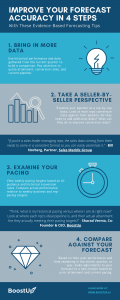The Revenue Blog /
Evidence-Based Forecasting: 6 Big Takeaways From The Revenue Collective Webinar.
Evidence-Based Forecasting: 6 Big Takeaways From The Revenue Collective Webinar.

Topics covered in this article
Recently, BoostUp Co-Founder & CEO Sharad Verma joined Bill Norberg, Partner at Sales Meddic Group, and Jeff Ignacio, Head of Revenue and Growth Operations at UpKeep on a Revenue Collective webinar to discuss evidence-based forecasting and how it will improve sales forecasting accuracy.
As we know, an accurate and reliable forecast is crucial to the success of a sales organization. However, unfortunately, many times, forecasts are created from incomplete or flawed data, with improper methods, and are even impacted by the emotions of those who create them. As good as those forecasts may make us feel, they are actually detrimental to the company, leading to faulty planning, resources allocation, and ultimately missed opportunities.
Enter Evidence-Based Forecasting… a forecasting method rooted in pure evidence, built on precise data, and leverages technology to generate accurate, honest forecasts that sales reps and teams can achieve.
What is Evidence-Based Forecasting?
Evidence-Based Forecasting is a sales planning and forecasting approach that utilizes sales data and metrics to build a predictable and accurate forecast for an organization. An evidence-based forecast uses historical data and performance metrics to analyze current trends and determine an outcome.
This type of forecasting eliminates the seller’s emotions and favors hard evidence. No longer will a seller use their gut instinct on whether or not a deal will close.
Who is Responsible?
Sharad argues that sellers should not be doing any forecasting in this new age of revenue operations, as it is their job to progress and close deals. “It’s not the rep’s job to forecast. The rep’s job is to close deals. The job of the manager is to help the rep close deals. It is the planners or decision-makers or resource owners – which is your CRO or RevOps – they should be forecasting,” says Sharad.
It is the sales reps’ job to provide accurate and consistent data that will help the operations roles create a forecast.
In many ways, it is the job of technology to gather data and present the information necessary to create that forecast, especially with the modern-day dispersed workforce’s precarious state and the massive amount of data it generates.
Why Organizations Need It
Evidence-based forecasting provides a true picture of the sales team’s progress against their goals, identifies weak points, and wins.
For operations teams, they can pinpoint exactly where improvements need to be made, how resources can be best allocated, what adjustments will improve progress against goals, and what can be done to increase sales performance.
For sales leaders and managers, evidence-based forecasting can provide them with the insights necessary to improve individual sales reps’ effectiveness through sales coaching. They can identify reps who are underperforming against their goals, who have win rates that are historically lower or are not converting leads, and specifically address their needs to improve overall sales performance.
Evidence-Based Metrics that Indicate a Winning Deal
With an evidence-based approach and the ability to monitor specific deal metrics, sales teams can actually analyze a deal’s health beyond just a gut feeling from the seller. There are several true indicators of deal health. These are:
- Documents over time – Data shows that a healthy deal with a high chance of a win has a progression in which more and more documents are shared over time, especially right before a successful close. Teams should see documents begin to be exchanged more frequently as the deal goes on.
- Number of engaged contacts – Very few sales nowadays involves a single point of contact. The vast majority are multi-threaded. Deals with a high win rate show the number of involved contacts increases over a period of time. However, these must be engaged contacts. CC’s on emails don’t count. They must be actively involved in the discussion and participate in meetings.
- Time between meetings – As a winning deal progresses, the time between meetings decreases. This shows excitement and involvement from both sides as they move toward their common goal.
Potential Difficulties with Evidence-Based Forecasting
Bill Norberg points out that since evidence-based forecasting is data-oriented, an issue for many teams will be data consistency, “If you’re a sales leader managing reps, the sales data coming from them needs to come in a consistent format so you can easily assimilate it.”
Bill also believes that teams will need to become experts in sales resource allocation. When teams gain the ability to understand which active deals may be failing, they need to prioritize which deals they can actually save versus those that are lost for good and how to properly allocate resources to recovering deals and continuing to generate new ones.
Evidence-Based Forecasting and RevOps
With the establishment of revenue operations and their crucial role in improving sales performance, RevOps is now a key part of sales forecasting. Sharad says, “RevOps is in the room. They own forecasting, and it’s not just from excel. They are actually in the room, in the conversations. In the big deals, they are reading the email and listening to the calls. Ops is getting into the deals.” In the future, be prepared to see further involvement from revenue operations.
Watch the replay of the event.
Want to learn how to improve your sales forecast accuracy in 4 simple steps?
Download the free infographic here.




-Photoroom.png)